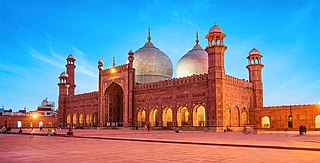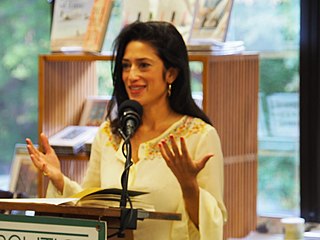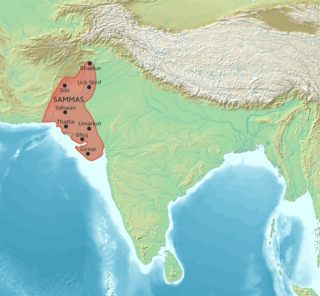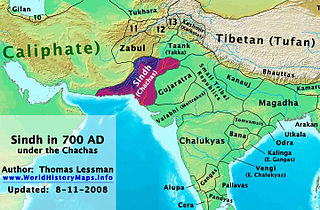Related Research Articles

Punjab is a province of Pakistan. Located in central-eastern region of the country, Punjab is the second-largest province of Pakistan by land area and the largest by population. Lahore is the capital and the largest city of the province. Other major cities include Faisalabad, Rawalpindi, Gujranwala and Multan.

Lahore is the capital and largest city of the Pakistani province of Punjab. It is the second largest city in Pakistan, after Karachi, and 26th largest in the world, with a population of over 13 million. It is located in the north-eastern region of Punjab, along the River Ravi. Lahore is one of Pakistan's major industrial and economic hubs. It has been the historic capital and cultural centre of the wider Punjab region, and is one of Pakistan's most socially liberal, progressive, and cosmopolitan cities.

Muḥammad ibn al-Qāsim al-Thaqafī was an Arab military commander in service of the Umayyad Caliphate who led the Muslim conquest of Sindh, inaugurating the Umayyad campaigns in India. His military exploits led to the establishment of the Islamic province of Sindh, and the takeover of the region from the Sindhi Brahman dynasty and its ruler, Raja Dahir, who was subsequently decapitated with his head sent to al-Hajjaj ibn Yusuf in Basra. With the capture of the then-capital of Aror by Arab forces, Muhammad ibn al-Qasim became the first Muslim to have successfully captured Hindu land, which marked the beginning of Muslim rule in South Asia.

Multan is a city in Punjab, Pakistan, located on the bank of Chenab River. Multan is one of the five largest urban centres of Pakistan in 2024 and is the major cultural, religious and economic centre of Southern Punjab. Multan is known for its rich ancient heritage and historic landmarks. The city is one of the oldest inhabited cities of Asia, with a history stretching deep into antiquity. A historic capital of Punjab and a significant cultural centre of Indus Valley civilization. Multan region was centre of many civilizations in its 5 millennia old history.

Ahmed Raza Khan Barelvi, known reverentially as Ala Hazrat, was an Indian Islamic scholar, theologian, Mujadid or reviver of Islam jurist, preacher, poet from Bareilly, British India, considered as the founder of the Barelvi movement and the Razvi branch of the Qadri Sufi order.

Fatima Bhutto is a Pakistani writer and columnist. Born in Kabul, she is the daughter of politician Murtaza Bhutto, sister of Zulfikar Ali Bhutto Jr, niece of former Pakistani Prime Minister Benazir Bhutto and granddaughter of former Prime Minister and President of Pakistan, Zulfiqar Ali Bhutto. She was raised in Syria and Karachi, and received her bachelor's degree from Barnard College, followed by a master's degree from the SOAS University of London.

Ayesha Jalal is a Pakistani-American historian who serves as the Mary Richardson Professor of History at Tufts University, and was the recipient of the 1998 MacArthur Foundation Fellowship.
The Rai dynasty was a polity of ancient Sindh. All that is known about the dynasty comes from the Chach Nama; recent scholarship has tried to corroborate the existence of the dynasty from contemporary coin finds but such attempts remain speculative and unconvincing.
Chach Nama, also known as the Fateh nama Sindh, and as Tareekh al-Hind wa a's-Sind, is one of the main historical sources for the history of Sindh in the seventh to eighth centuries CE, written in Persian.
Phalia is a town and headquarters of Phalia Tehsil of Mandi Bahauddin District, Punjab, Pakistan.
Raja Dahir was the last Hindu ruler of Sindh. A Brahmin ruler, his kingdom was invaded in 711 CE by the Arab Umayyad Caliphate, led by Muhammad bin Qasim, where Dahir died while defending his kingdom. According to the Chachnama, the Umayyad campaign against Dahir was due to a pirate raid off the coast of the Sindhi coast that resulted in gifts to the Umayyad caliph from the king of Serendib being stolen.

Samma is a community called Sammat and a tribe that has origins in Sindh. The Samma are spread across Pakistan and North-West India. The Sandhai Muslims are Samma who converted to Islam. Offshoots of the main branch of Samma include the Jadejas and Chudasamas of India.

This is a timeline of Pakistani history, comprising important legal and territorial changes and political events in the region of modern-day Pakistan. To read about the background of these events, see History of Pakistan and History of the Islamic Republic of Pakistan.

Rani Suhanadi, also known as Sohman Devi, was a Sindhi queen consort. She was married to first Rai Sahasi II of the Rai dynasty, and secondly to Chach of Aror, Maharaja of Sindh. She is known for her role in the succession of her first husband, thus establishing a new dynasty.

Ishtiaq Ahmed is a Swedish political scientist and author of Pakistani descent. He holds a PhD in Political Science from Stockholm University. He is Professor Emeritus of Political Science at Stockholm University. Ahmed’s work provides a comprehensive and critical examination of the political history of South Asia, particularly focusing on the partition of India and the role of key figures like Jinnah. His writings offer valuable insights into the complex dynamics of religion, language, and politics in the region.
Ustad Bashir Ahmed is a Pakistani painter, also known as Mughal Miniature Painter.

The Umayyad conquest of Sindh took place in 711 AD against the ruling Brahmin dynasty of Sindh and resulted in Sindh being incorporated as a province into the Umayyad Caliphate. The conquest resulted in the overthrow of the last Hindu dynasty of Sindh, the Brahman dynasty, after the death of Raja Dahir.
Creating a New Medina: State Power, Islam, and the Quest for Pakistan in Late Colonial North India is an academic monograph on the Partition of India by Venkat Dhulipala, a Professor of South Asian History at University of North Carolina. The work attracted mixed reception — while Ian Talbot, Gail Minault and David Gilmartin admired the work as a significant intervention, reviews by Barbara D. Metcalf, Faisal Devji, Yasmin Khan, Manan Ahmed Asif, and Julian Levesque were scathing.
The eleventh-century Shahnameh of Ferdowsi preserves the earliest version of the Alexander Romance in the Persian language, following closely the text in its Syriac translation. The Romance genre functioned to preserve and describe the legends and exploits of Alexander the Great. Although the Shahnameh is a much larger text and contains legends of many other rulers of Greater Iran, three consecutive sections of it cover Alexander, amounting to ~2,500 verses. Furthermore, the sections about Alexander act as a bridge between the narratives of the kings before and after him, representing a transition from a realm of mythological kings and exploits to the historical kings of the Sasanian Empire.
References
- ↑ "Columbia University Department of History". Columbia University. 13 June 2016. Retrieved 3 May 2022.
- ↑ "About". Chapati Mystery. Retrieved 20 February 2024.
- ↑ "Group for Experimental Methods in Humanistic Research". Group for Experimental Methods in Humanistic Research at Columbia University. Retrieved 20 February 2024.
- ↑ "Manan Ahmed has been appointed as one of the new Executive Editors of Journal of the History of Ideas". Department of History - Columbia University. 20 July 2021. Retrieved 20 February 2024.
- ↑ "MARGINS, HISTORY, COSMOPOLITANISM an interview with Manan Ahmed". Columbia Journal of Literary Criticism. 18 September 2015. Retrieved 20 February 2024.
- ↑ "Ahmed, Manan". Department of History - Columbia University. 13 June 2016. Retrieved 20 February 2024.
- ↑ "Ahmed, Manan". Department of History - Columbia University. 13 June 2016. Retrieved 20 February 2024.
- ↑ "Senior Theses in Their Own Words". The Current. Retrieved 20 February 2024.
- ↑ "Senior Theses in Their Own Words". The Current. Retrieved 20 February 2024.
- ↑ "Columbia University Department of History". Columbia University. 13 June 2016. Retrieved 15 October 2016.
- ↑ Venkataramakrishnan, Rohan (12 December 2020). "Interview: Manan Ahmed Asif on the 'Loss of Hindustan' and how colonialism altered our past". Scroll.in. Retrieved 20 February 2024.
- ↑ Ahmed, Manan (December 2008). The Many Histories of Muhammad b. Qasim: Narrating the Muslim Conquest of Sindh (PhD in South Asian Languages and Civilizations thesis). The University of Chicago. ProQuest 304406685.
- ↑ Venkataramakrishnan, Rohan (12 December 2020). "Interview: Manan Ahmed Asif on the 'Loss of Hindustan' and how colonialism altered our past". Scroll.in. Retrieved 20 February 2024.
- ↑ Kumar, Anu A Misconstrued Narrative of Conquest – Manan Ahmed Asif on the 12th Century ‘Chachnama’, The Wire (thewire.in), December 24, 2016
- ↑ Zutshi, Chitralekha (2017-12-11). "Manan Ahmed Asif. A Book of Conquest: The Chachnama and Muslim Origins in South Asia". The American Historical Review. Vol. 122, no. 5. pp. 1583–1584. doi:10.1093/ahr/122.5.1583.
- ↑ Dreyfuss, Emily (2018-06-25). "'ICE Is Everywhere': Using Library Science to Map the Separation Crisis". Wired. ISSN 1059-1028 . Retrieved 2019-05-22.
- ↑ Martinez, Norma. "Fronteras: Digitally Mapping Trump Administration's 'Zero Tolerance' Policy". www.tpr.org. Retrieved 2019-05-22.
- ↑ "A shocking map of America's vast "immigrant detention machine"". perma.cc. Retrieved 2019-05-22.
- ↑ Fournier, Jess. "Torn Apart: Mapping the Geography of U.S. Immigration Policy". Feministing. Retrieved 2019-05-22.